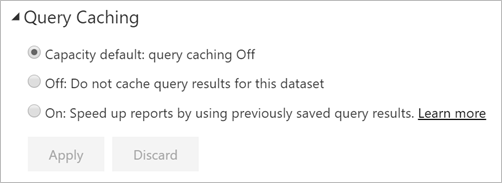Boost performance with query caching (Premium)
With the Query Caching feature, you can use the local caching services of Power BI to process query results. Instead of relying on the semantic model to calculate queries, you use cloud resources on your Premium capacities in the Power BI service to load your report. Query caching ensures constant performance instead of overloading the semantic model resources.
Building on the scenario, you notice that some of your semantic models are causing the reports to load more slowly than before, an issue that is starting to annoy your users. The Sales team wants to know how they can improve performance and make these reports load faster. You decide to use Query Caching to solve this problem.
Query caching
Query Caching is a local caching feature that maintains results on a user and report basis. Query caching reduces load time and increases query speed, especially for semantic models that aren't refreshed often and are accessed frequently. This service is only available to users with Power BI Premium or Power BI Embedded.
Query caching results are user-specific, and apply specific page of a report only. Several benefits to using query caching include:
Improvement of the performance of reports, dashboards, and dashboard tiles.
It respects bookmarks and default filters.
Cached query results are specific to the user.
All security labels are followed.
It reduces the load on your dedicated capacity.
To access and configure query caching, follow these steps:
Go to a semantic model in your workspace and open its Settings page. In this example, you enable query caching for SalesModel.
Select the semantic models tab and expand the Query Caching options, as shown in the following image.
On the Query Caching page, choose one of the available options. The default option is that query caching is turned off; however, you can also select Off, which turns off query caching for the specific semantic model in question. If you select On, query caching is turned on for this specific semantic model only. For this example, you'll select On for your semantic model because you want to apply query caching to your specific semantic model.
Note
Switching from On to Off clears all previously saved query results. When turning off query caching (either through the default or the Off option), a small delay occurs in query loading because the report queries are running against the semantic model and it does not have saved queries to fall back on.
Warning
If many semantic models have query caching enabled, and a refresh occurs, a reduction in performance might occur because a large number of queries are being processed at once.
For more information, see Query Caching in Power BI.

